Some Kinetoscope Films by A. E. Weed
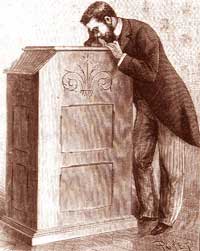 At the end of the 19th Century, kinetoscope parlors had sprung up across America, & the public thirst for movies had erupted like a volcano.
At the end of the 19th Century, kinetoscope parlors had sprung up across America, & the public thirst for movies had erupted like a volcano.
The earlier kinetoscopes played less than a half-minute of film at a time, & the better ones played two-minute films, edging up to three minute films. The films weren't projected so were not a group experience. One person at a time would gaze into the peephole or view window of a film, & for a penny or a nickle start the handcrank going.
A great many films were made that were twenty seconds long (thirty seconds if you turned the crank a bit slower) up to two or three minutes long. "Feature" films were ten or fifteen minutes long & were viewed one episode at a time by moving along a bank of kinetoscopes gazing into the viewer one by one.
Though it seemed like cheap entertainment, five cents for two minutes, or two-bits for a five-part film viewed in five machines, & if you brought someone along they'd be two minutes behind you going from one machine to another, it added up fast.
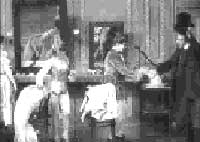 Comedies, or comic situations, were always popular, as a fairly elaborate gag could be enacted in a short period of time & even resemble a complete story. Comedies, or comic situations, were always popular, as a fairly elaborate gag could be enacted in a short period of time & even resemble a complete story.
And because men were the first & long the largest audience in the kinetoscope parlors, the jokes could sometimes be a might seedy. Burlesque events were very common, dancing girls in particular, or scenarios which put a bumbling male figure into the presence of burlesque queens.
Mr. Jack in the Dressing Room (1904) was filmed by A. E. Weed. A whiskery, thick-set Mr. Jack, arrives in the women's dressing room at a theater. He has brought wine to toast the production, doing a quick little jig of happiness.
He then rolled up his pants to reveal a bit of leg as the girls put him in a skirt (or a big apron that looks like a skirt from the front). He dances about the room in the flouncy skirt when to his horror his wife comes in, swinging her umbrella, wacking him as she leads him out, still in the skirt.
The one-minute comedy even for this early date is by no means cinema's the first use of crossdressing as humor. Already a common type of shtick for the vaudeville stage, it was a natural for short-short scenes on kinetoscope. And making the guy a foolish clown for being so eager to see girls in various states of undress between costumes was the perfect context for men to view the ladies themselves while pretending to be more interested in the joke on the rube.
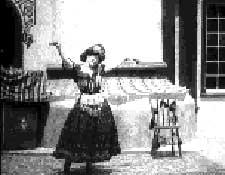 A. E. Weed was a "man's" director of burtesques. He would become the regular camera man for Frederick Armitag & Wallace McCutcheon kinetoscope films, but in 1903 & 1904 he made a few things on his own, & even if just listed as a cameraman, he was often fully responisible for every aspect of the film he turned in.
A. E. Weed was a "man's" director of burtesques. He would become the regular camera man for Frederick Armitag & Wallace McCutcheon kinetoscope films, but in 1903 & 1904 he made a few things on his own, & even if just listed as a cameraman, he was often fully responisible for every aspect of the film he turned in.
Dances were popular subjects, because they were lively with motion, a must for the kinetoscope, & the dances tended to be done by pretty young women, a must for the largely male audience. And yet the films shouldn't be so obviously erotic as to get the kinetoscope parlor closed down or the film confiscated by the police.
Princess Rajah Dance (1904) filmed by Weed at one minute shows the vaudevillian who billed herself as Princess Rajah in a long skirt doing her orientalist hoochy bust-wobbling dance on an Afghan carpet, then lifting a chair above her head with only her teeth & combining a balancing act with her dance moves. Wackily talented gal with strong teeth.
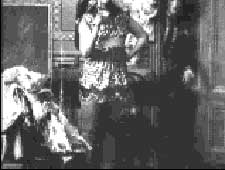 Watching films by leaning over & gazing into a small window was inherently vouyearistic & many a film truly placed the viewer in the position of a peeping tom. Watching films by leaning over & gazing into a small window was inherently vouyearistic & many a film truly placed the viewer in the position of a peeping tom.
A. E. Weed's From Show Girl to Burlesque Queen (1903) turns a vaudeville gal's dressing room into a private peep show, a style of burly-q act that would still be popular in the 1950s during the last era of live burlesque theater.
A showgirl in a glorious gown is shown in her dressing room taking off her garments one by one, as though all alone.
She walks behind a screen before she removes her slip, tossing it on the back of the chair in the camera frame, begging for the imagination to do some work. When she steps out from behind the screen, she's now dressed for a sexy burlesque show.
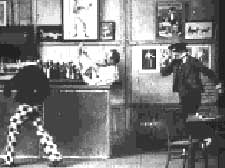 It appears that given his preferences, if he was going to be stuck on assignment recording burlesque shows, A. E. Weed preferred the comedy acts. Alphonse & Gaston No. 3 (1903) is a mini-play intended representing a wild west saloon, based on Frederick Burr Opper's comic strip characters.
It appears that given his preferences, if he was going to be stuck on assignment recording burlesque shows, A. E. Weed preferred the comedy acts. Alphonse & Gaston No. 3 (1903) is a mini-play intended representing a wild west saloon, based on Frederick Burr Opper's comic strip characters.
The characters debuted in the New York Journal in 1901, & were soon being recreated in the vaudeville theaters. Their standard gag was "you first" "oh no pardon me, you go first" "no please, you go first" which made good vaudeville shtick.
The wee film is staged in an elaborate little set with pictures on the saloon wall showing a boxer, horses, a ballerina & suchlike.
Alphone wears crazy checkered pants, Gaston a blunt conical Italian hat similar to Chico Marx (who inherited the character type from vaudevile), though in the comix they wore miniature pilgrim hats.
Ordering a single beer, likely because they don't have enough money for two beers, they play a game of "you have the first sip" "no, you have it" placing the beer bottle back & forth along the bar.
A cowboy comes in & notices that the eastern dandies are idiots. So he draws his gun, fires at their feet, & makes them do a ridiculous dance right out of the bar. The bartender laughs as the cowboy claims their beer as his own.
By being made visitors to a western saloon, Alphonse & Gaston No 3 is defacto one of the earliest westerns. It's given as No. 3 obviously because several of these gag-films were made, but I've not seen these others: Robert K. Bonine's The Polite Policeman (1902) in additon to Weed's Alphonse & Gaston No. 1 (1903) & Alphonse & Gaston No. 2 (1903). If they still exist I hope to see them someday.
Frederick Burr Opper also created the comic strip character Happy Hooligan, & A. E. Weed made at least two films in that series in 1903, but I've thus far only seen two earlier episodes not by Weed, & I suspect most of the rest (eight titles that I know of) don't survive.
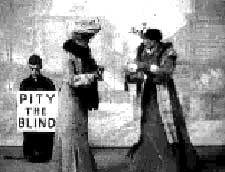 Another skit filmed by Weed was Pity the Blind No. 2 (1904). It is a very simple vaudeville joke, descendants of which are acted out in comic interludes to this day.
Another skit filmed by Weed was Pity the Blind No. 2 (1904). It is a very simple vaudeville joke, descendants of which are acted out in comic interludes to this day.
A blind man is lead to the center of the stage, a village street scene painted on the backdrop.
He has a sign "Pity the Blind" & accepts hand-outs from passersby. But when an attractive woman raises her skirt to adjust a stocking, the blind man can obviously see perfectly well.
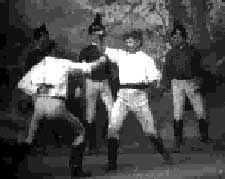 It was rare that vaudeville did serious drama but it wasn't out of the question to do something that was neither a jest nor a sex tease. Weed directed one of those rare "serioius" pieces, Duel Scene "By Right of Sword" (1904). It was rare that vaudeville did serious drama but it wasn't out of the question to do something that was neither a jest nor a sex tease. Weed directed one of those rare "serioius" pieces, Duel Scene "By Right of Sword" (1904).
Duelists & their seconds meet in the forest; or, rather, on a stage with a backdrop of a painted forest, ready to act out the dueling scene from Arthur W. Marchmont's swashbuckling novel By Right of Sword (1897).
The duelists salute one another & begin. It's really very well choreographed, for stagey swordplay skills were very commonly taught for the sake of Shakespeare plays, & inevitably found their way into other venues, including vaudeville.
It's not a duel to the death. When one man wounds the other's hand, the winner is decided. They both put on their cloaks & the defeated man storms away a mite bitterly, while the soldier who served as the winner's second salutes him.
copyright © by Paghat the Ratgirl
|
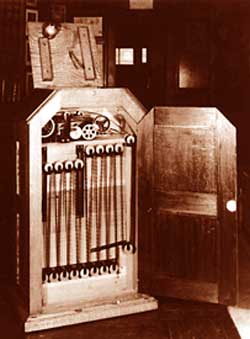



 Watching films by leaning over & gazing into a small window was inherently vouyearistic & many a film truly placed the viewer in the position of a peeping tom.
Watching films by leaning over & gazing into a small window was inherently vouyearistic & many a film truly placed the viewer in the position of a peeping tom.

 It was rare that vaudeville did serious drama but it wasn't out of the question to do something that was neither a jest nor a sex tease. Weed directed one of those rare "serioius" pieces, Duel Scene "By Right of Sword" (1904).
It was rare that vaudeville did serious drama but it wasn't out of the question to do something that was neither a jest nor a sex tease. Weed directed one of those rare "serioius" pieces, Duel Scene "By Right of Sword" (1904).